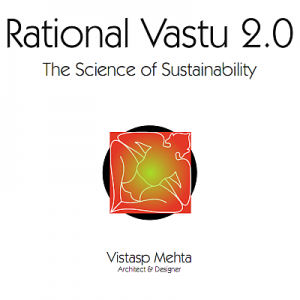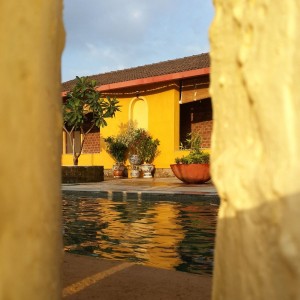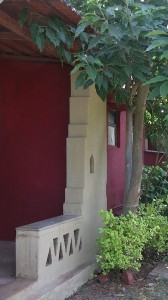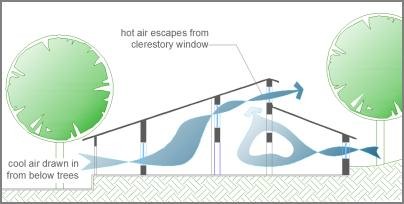The lives of birds and insects are so closely intertwined that you’re unlikely to have one without the other and both are extremely dependent on plants for shelter and sustenance. In nature, nothing works in isolation so, if you want to attract what are generally considered “beautiful creatures” to your garden, you have to be willing to accept the less popular ones. If you want butterflies, you will also have caterpillars and if you want birds you have to be willing to accept all manner of insects – some of which will attack your plants.
Despite that, it is extremely important to avoid chemical pesticides and fertilisers that will either kill them or drive them away. Unlike plants that are able to selectively repel certain types of creatures, man-made chemicals are less discriminating. Instead, if you want to keep the caterpillars (and other plant-eating insects) in check, make sure your garden also attracts birds. Butterflies and their caterpillars are themselves food for many birds and if the garden isn’t attractive to birds, the caterpillars will eat everything in sight. It’s just part of the balance of nature.
This page gives a list of trees and shrubs that you could plant to attract both, birds and butterflies. I have not given separate lists because the two of them pretty much sail and sink together.
Ways to Attract Butterflies
Creating a garden that consistently attracts butterflies is not all that difficult. You don’t necessarily need a lot of space – although that naturally helps – but you will need to learn a bit about these beautiful creatures before you begin. What this page will give you, is only a primer to start you off because the species of butterflies found in different parts of our country vary quite dramatically.
The first thing you need to provide if you want to attract these beautiful creatures to your garden, is a habitat they can be comfortable with. This means planting everything from dense shrubs that shelter them from predators and rain to tall trees (which some of the larger butterflies frequent in an activity known as “tree-topping”) while also leaving open space for them to bask close to the ground. Being cold-blooded insects, they need to warm their wings in the sun before they can take flight in the morning.
The second thing you need to do is bribe them outright! Many (though by no means all) adult butterflies feed on the nectar of flowers. In doing so, they act as couriers for the pollen grains that stick to their bodies, thereby helping in pollination making it a symbiotic relationship. By and large, butterflies prefer to visit multiple small florets as opposed to single large flowers so you might want to look for plants that have these characteristics. It is helpful to have a variety of plants so that their different flowering seasons ensure availability of nectar through the year.
The third important thing that most people don’t realise is that it is not enough to merely attract the adults; if you want their continued presence, you must provide for their young as well. Caterpillars (and here’s something you might not know) are very specific about the plant they feed on. Caterpillars of any given butterfly species will only feed on a single plant species or sometimes a bunch of related plant species. For instance, many of the smaller lycanid caterpillars will only feed on grasses while, say, a tiger butterfly will hunt for a certain milkweed (Calotropis) on which to lay her eggs – and a Red Pierrot caterpillar will restrict itself to the fleshy leaf of Bryophyllum. Put the red pierrot caterpillar on a tree full of juicy green leaves and it will simply die of starvation.
One more thing that is easily provided and will attract a lot of male butterflies during the dry months is a patch of damp earth. Males flock to such patches for “mud-puddling” wherein they get salts and other nutrients from the soil which they need to be considered eligible by the females. And if you really start getting addicted to butterflies, you can also bait some species with rotten and fermenting fruit; the little alcoholics will simply love you!
How to Attract Birds
Like butterflies, birds also require a variety of plant types to make them visit your garden. Some birds like thrushes and babblers prefer to forage in the shade, Sunbirds go to nectar-rich flowers while parakeets and Barbets want to get at fruits and seeds that are usually found in the larger trees like the fig. One therefore needs to plant a tiered garden with patches of sunlight on the one hand and dense shade on the other. Also, birds usually prefer local vegetation so keep that in mind when you do your plantation.
Install a bird-bath. It’s not very difficult to make and as long as you don’t have cats as pets (or neighbours), the birds will give you hours of enjoyment. There are numerous pages on the internet that explain how to make a birdbath. Just one thing to remember is that if you leave the water stagnant, you will be breeding mosquitoes – not a pleasant thing.
The trees you plant should be dense and shade-giving. These will give great shelter for roosting or even nesting. And if they happen to be fruit-bearing, that is even better. Bushes, especially flowering ones, should be planted around the trees in clusters instead of scattered all over the place.
As with any nature-friendly place, you should avoid (or at least minimise) the use of chemical fertilisers and pesticides. Pesticides will eliminate a broad range of insects and spiders some of which you may not be very keen on but which are extremely attractive to our feathered friends. A garden devoid of insects will get very few birds visiting especially during the nesting season when they’re foraging for their young. Nothing exists in isolation in nature and if you want to look at pretty creatures, you’ll have to learn to look at and enjoy the ones that aren’t as popular.


 As an Architect, I have often been confronted by my clients’ blind faith in the Vastu Shastras — the ancient building code of India. At first, I dismissed it out of hand; but the trend refused to die. Finally, I decided to take a closer look at this phenomenon, hoping to gather enough evidence against it.
As an Architect, I have often been confronted by my clients’ blind faith in the Vastu Shastras — the ancient building code of India. At first, I dismissed it out of hand; but the trend refused to die. Finally, I decided to take a closer look at this phenomenon, hoping to gather enough evidence against it.




